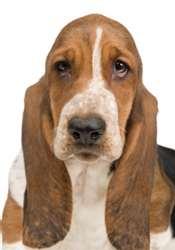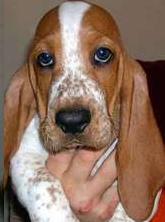


Basset Care
Basset care is really quite simple if you start as you mean to go on, if you begin with the wrong knowledge or ethic your life could become difficult, however following simple rules will make life so much easier for both you and your Basset Hound - a good rule to start with is don't allow your Basset Hound to do anything at 10 weeks you don't want to see it doing at 10 months or 10 years......once learn and allowed to get away with it - the behaviour is as good as set in stone!!
One of the major responsibilities of the conscientious owner is to ensure that a thorough veterinary check-up is carried out annually. Between visits you should perform routine checks at home on a daily and weekly basis in order to assess any changes in your dogs which may indicate that an early visit to the vet is required.
Daily Checks:
Eating and drinking
Some dogs may go off their food for a day and this will not harm them, but if a previously enthusiastic eater is rejecting food for more than twenty-four hours your vet should be consulted as any changes in feeding habits may signify a problem. Similarly, drinking patterns should be observed. Any deviation from the norm, particularly an increase in water consumption, should be investigated.
Mobility
Watch the way your Basset moves. Look for any signs of lameness and for any swelling on the legs or joints. Does it show any reluctance to walk, run, or play. Does it seem stiff when he gets up from a rest. Does it show any discomfort when touched on any part of his body. Arthritis is one of several causes of lameness and discomfort which can be alleviated by medication
Toilet Time
Observing your Basset’s toilet habits may provide valuable insight into the health of your dog.The number of bowel movements per day varies considerably from dog to dog. The important thing is that the evacuations are regular and of consistent appearance. Bear in mind that certain foods may change the colour of the faeces, e.g. charcoal biscuits will produce black faeces. Any chronic or acute diarrhoea or constipation requires veterinary attention, as does the presence of blood or mucus. If the urine appears dark, cloudy, or blood tinged, or the dog is urinating excessively or has difficulty in passing urine, again, consult your vet.
Respiration
Coughing, breathlessness, or excessive panting may indicate problems.
General demeanour
As with humans, dogs can be energetic one day and lethargic the next. However, any major fluctuation in normal energy levels lasting more than a couple of days should be investigated.
Weekly Checks:
Grooming and general check
Grooming requirements depend upon the breed but most dogs require at least a weekly going over. This time can be invaluable for a general check-up. Run your hands over every part of your dog’s body to check for lumps and bumps,. Examine the skin top to toe, stomach, armpits and under the tail for any cuts, scratches, inflammation, hot spots, parasites, dandruff, etc. Note any signs of discomfort when being handled and listen to the chest for wheezing.
Feet
Examine the feet carefully. Look and feel between the toes and between the pads for any soreness, grass seeds, cysts, ticks, or excessive hair. Over-long nails can cause problems so they should be kept trimmed as short as possible. Nails can be cut using specially designed clippers, or they can be filed. Be careful when shortening nails to avoid the quick as cutting this will result in bleeding and will cause the dog pain.
Ears
Smell the ears. Any unpleasant odour is a sign of problems. Wax build-up can be gently removed with cotton wool, but never poke anything down into the ear. If your dog’s ears need a thorough cleaning then this must be done by a vet. If the ear is swollen or red this is indicative of inflammation which will need veterinary attention.
Eyes
The eyes should have no excessive discharge. Gently wipe the corners of the eyes to remove any build-up of debris. Check the pupils to ensure that they are of the same size. The eyes should be clear with no cloudiness, no dull spot or bluish tinge. Check the eyelids and the edges of the eyes for any lumps. Check that there are no inward growing lashes. Any hair which obscures vision should be trimmed. If the dog shows any sign of eye irritation or soreness it should be taken to the vet.
Nose
There should be no discharge from the nose and no excessive sneezing. The dog should have no difficulty in breathing normally through its nose. The nose leather is usually moist and cool, but a warm dry nose is not necessarily indicative of illness. If the nose is very dry then oil or Vaseline will help restore it.
Mouth
Examine the teeth and gums. Gums should be pink, any redness may indicate a problem. Check for growths on the gums. Make sure that there are no broken or loose teeth and that the teeth are clean and have no brown accumulations of tartar or trapped food particles. Check the tongue for sores, cuts, growths. Check the lip folds for any accumulation of food. Smell the breath. If there is a foul odour this could be a sign of bad teeth, gum problems, or digestive problems.
Weight
If your dog is on a program to adjust his weight weekly recording of any increase or decrease is important. Obesity is the cause of a great many problems in the dog.
There is an old saying “An ounce of prevention is worth a pound of cure”, if you have any concerns at all about the health of your dog then consult your veterinarian promptly. Quite often early diagnosis of a potential problem will result in a quicker, more effective, and less costly, cure.
One of the major responsibilities of the conscientious owner is to ensure that a thorough veterinary check-up is carried out annually. Between visits you should perform routine checks at home on a daily and weekly basis in order to assess any changes in your dogs which may indicate that an early visit to the vet is required.
Daily Checks:
Eating and drinking
Some dogs may go off their food for a day and this will not harm them, but if a previously enthusiastic eater is rejecting food for more than twenty-four hours your vet should be consulted as any changes in feeding habits may signify a problem. Similarly, drinking patterns should be observed. Any deviation from the norm, particularly an increase in water consumption, should be investigated.
Mobility
Watch the way your Basset moves. Look for any signs of lameness and for any swelling on the legs or joints. Does it show any reluctance to walk, run, or play. Does it seem stiff when he gets up from a rest. Does it show any discomfort when touched on any part of his body. Arthritis is one of several causes of lameness and discomfort which can be alleviated by medication
Toilet Time
Observing your Basset’s toilet habits may provide valuable insight into the health of your dog.The number of bowel movements per day varies considerably from dog to dog. The important thing is that the evacuations are regular and of consistent appearance. Bear in mind that certain foods may change the colour of the faeces, e.g. charcoal biscuits will produce black faeces. Any chronic or acute diarrhoea or constipation requires veterinary attention, as does the presence of blood or mucus. If the urine appears dark, cloudy, or blood tinged, or the dog is urinating excessively or has difficulty in passing urine, again, consult your vet.
Respiration
Coughing, breathlessness, or excessive panting may indicate problems.
General demeanour
As with humans, dogs can be energetic one day and lethargic the next. However, any major fluctuation in normal energy levels lasting more than a couple of days should be investigated.
Weekly Checks:
Grooming and general check
Grooming requirements depend upon the breed but most dogs require at least a weekly going over. This time can be invaluable for a general check-up. Run your hands over every part of your dog’s body to check for lumps and bumps,. Examine the skin top to toe, stomach, armpits and under the tail for any cuts, scratches, inflammation, hot spots, parasites, dandruff, etc. Note any signs of discomfort when being handled and listen to the chest for wheezing.
Feet
Examine the feet carefully. Look and feel between the toes and between the pads for any soreness, grass seeds, cysts, ticks, or excessive hair. Over-long nails can cause problems so they should be kept trimmed as short as possible. Nails can be cut using specially designed clippers, or they can be filed. Be careful when shortening nails to avoid the quick as cutting this will result in bleeding and will cause the dog pain.
Ears
Smell the ears. Any unpleasant odour is a sign of problems. Wax build-up can be gently removed with cotton wool, but never poke anything down into the ear. If your dog’s ears need a thorough cleaning then this must be done by a vet. If the ear is swollen or red this is indicative of inflammation which will need veterinary attention.
Eyes
The eyes should have no excessive discharge. Gently wipe the corners of the eyes to remove any build-up of debris. Check the pupils to ensure that they are of the same size. The eyes should be clear with no cloudiness, no dull spot or bluish tinge. Check the eyelids and the edges of the eyes for any lumps. Check that there are no inward growing lashes. Any hair which obscures vision should be trimmed. If the dog shows any sign of eye irritation or soreness it should be taken to the vet.
Nose
There should be no discharge from the nose and no excessive sneezing. The dog should have no difficulty in breathing normally through its nose. The nose leather is usually moist and cool, but a warm dry nose is not necessarily indicative of illness. If the nose is very dry then oil or Vaseline will help restore it.
Mouth
Examine the teeth and gums. Gums should be pink, any redness may indicate a problem. Check for growths on the gums. Make sure that there are no broken or loose teeth and that the teeth are clean and have no brown accumulations of tartar or trapped food particles. Check the tongue for sores, cuts, growths. Check the lip folds for any accumulation of food. Smell the breath. If there is a foul odour this could be a sign of bad teeth, gum problems, or digestive problems.
Weight
If your dog is on a program to adjust his weight weekly recording of any increase or decrease is important. Obesity is the cause of a great many problems in the dog.
There is an old saying “An ounce of prevention is worth a pound of cure”, if you have any concerns at all about the health of your dog then consult your veterinarian promptly. Quite often early diagnosis of a potential problem will result in a quicker, more effective, and less costly, cure.
Working together with the
KENNEL CLUB
for a better tomorrow
KENNEL CLUB
for a better tomorrow








Official site of the Basset Hound Health Group
The Basset Hound Health Group - is run under the auspices of all 8 UK based Basset Hound Breed Clubs
The Basset Hound Health Group - is run under the auspices of all 8 UK based Basset Hound Breed Clubs